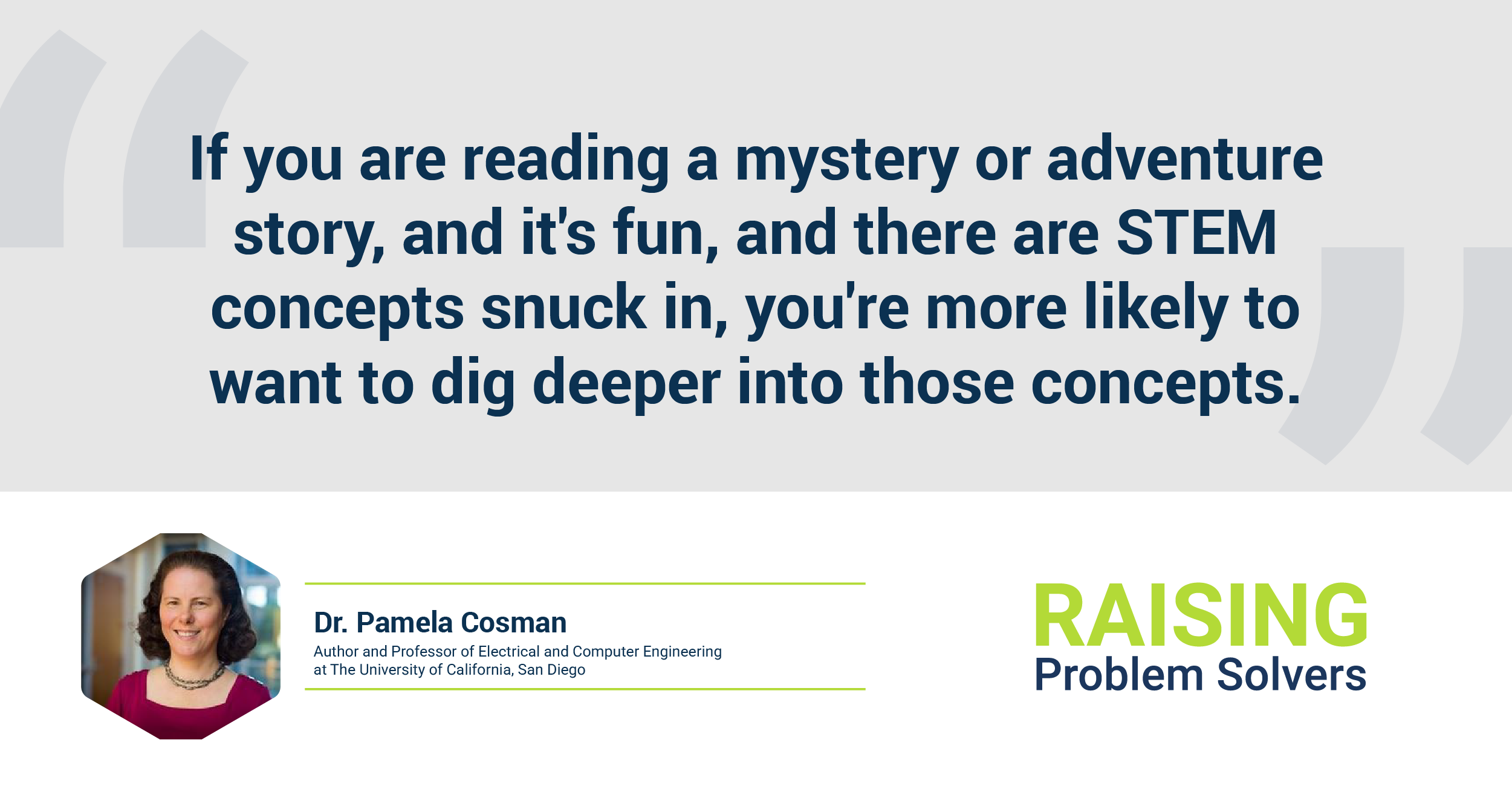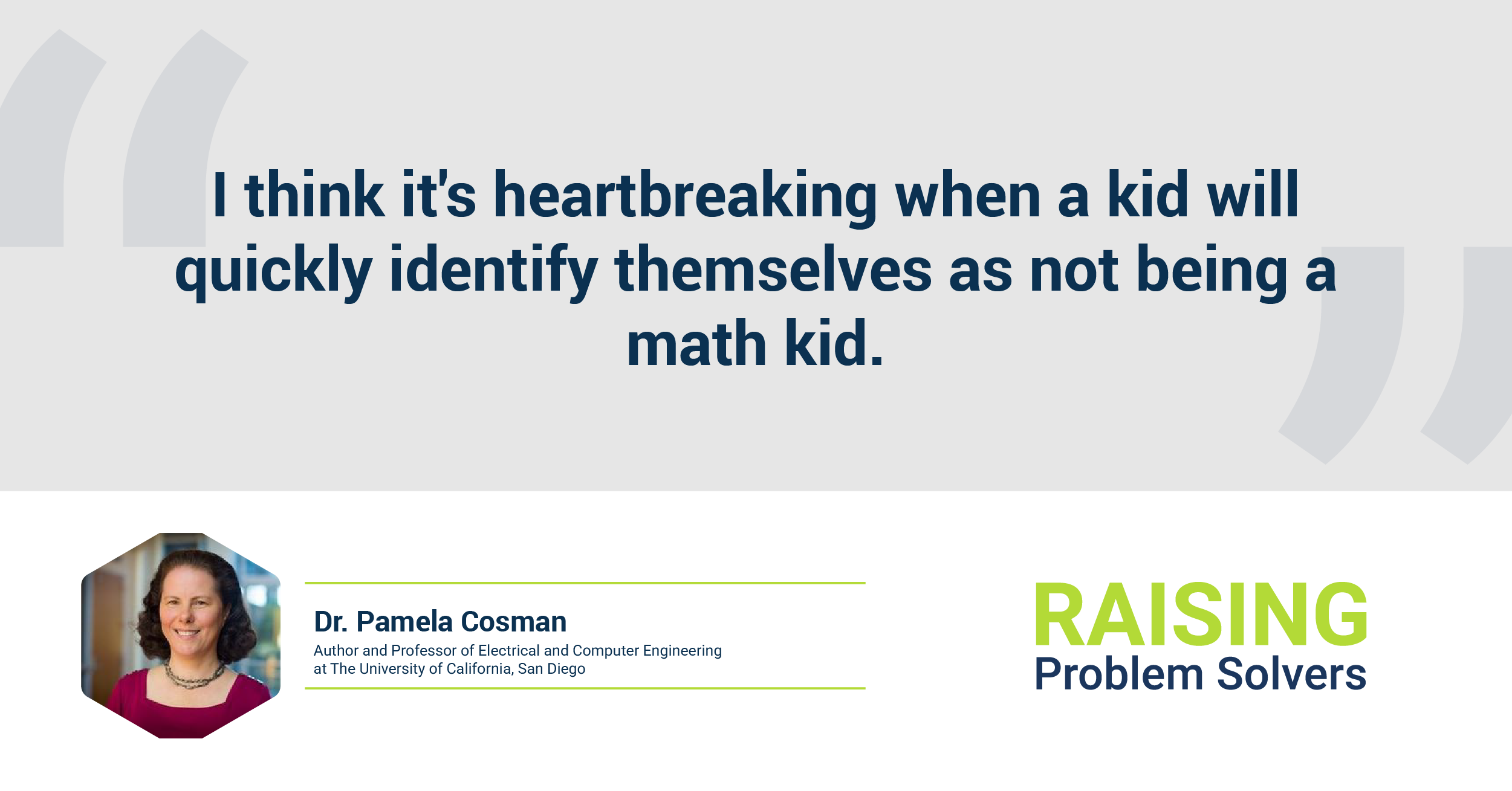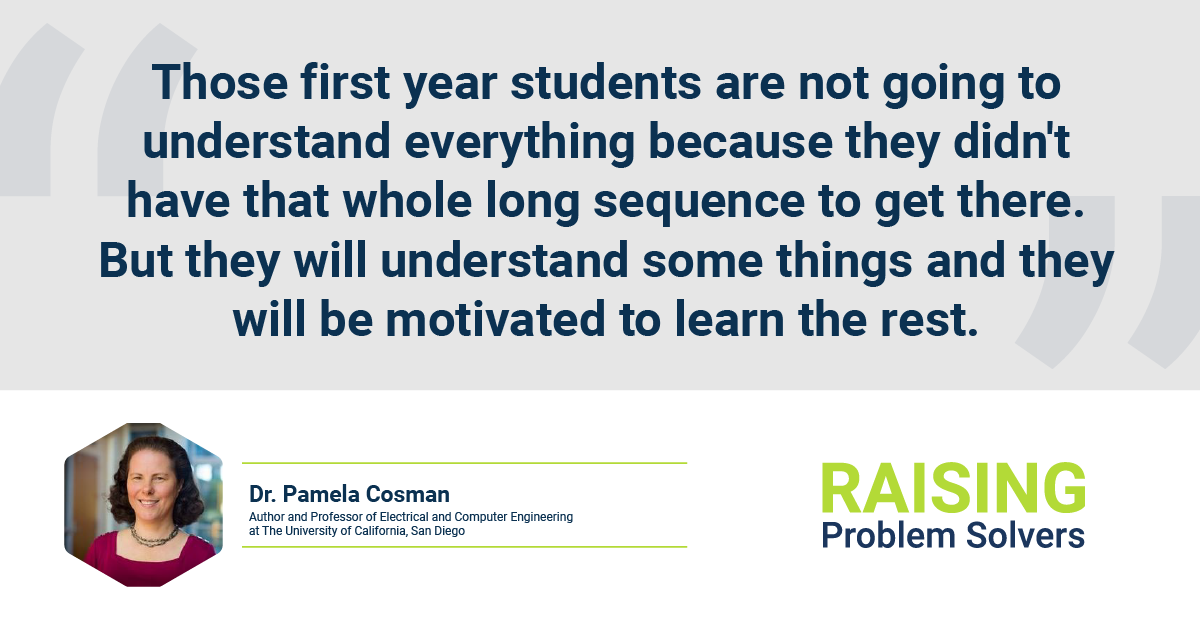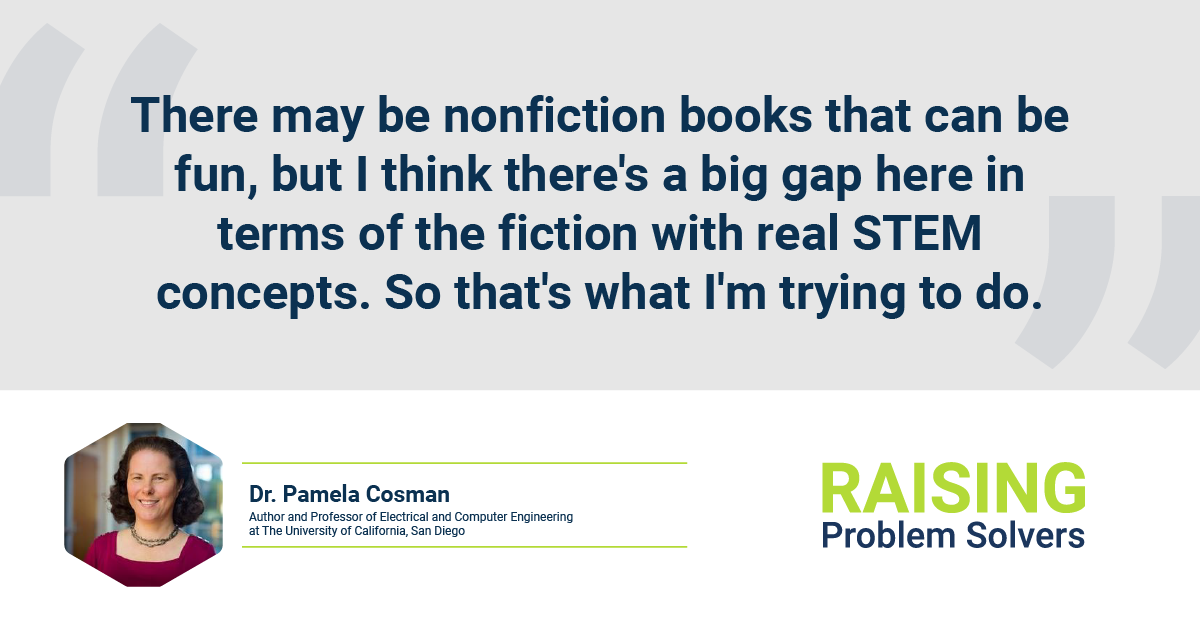Dr. Pamela Cosman, author and professor of electrical and computer engineering at the University of California, San Diego, talks about how to make STEM subjects more fun and engaging for kids, and the specific power of learning STEM through fiction.
Would you call yourself a “math person”?
So many students, and even adults, will classify themselves as a “math person” or “not a math person.” This is often to their own detriment.
“It’s heartbreaking when a student quickly identifies themselves as not being a math kid,” Pamela says. “It’s normalizing the idea that it's okay to have a closed mindset.”
Instead, students should have a growth mindset when it comes to STEM — and learning in general. And storytelling can help with that.
Dr. Pamela Cosman has turned to STEM storytelling to help capture students’ attention. This approach not only makes content more engaging and motivating, but exposes more students to lessons they might have otherwise disregarded.
STEM Subjects Taught through Story
Making a lesson fun through storytelling increases the likelihood a student will want to learn more — a notion Pamela champions through her series of books.
Recalling her series inspiration, Pamela shares her experience teaching a second grade classroom about sending secret coded messages. She explained it more as a game, using the scenario of passing notes in class. She was later surprised to learn that the students chose to spend their lunch that day coding and decoding messages: A lesson they viewed as a game.
Taking a step back, she realized those same Huffman coding concepts the second graders were treating as a game were the same concepts she taught her juniors and seniors at the University of California, San Diego.

Not only were those STEM concepts more digestible for a younger student, but also for those students who might have already sworn off STEM in general. Think of how many of those second grade students, now coding messages at lunch, would’ve never found an interest in STEM otherwise.
Origami Meets Aerospace Engineering
For many students and adults, the idea of self-classifying as a STEM student or a creative student is pretty typical. But doing so, according to Pamela, can be a dangerous mindset.
This behavior can normalize the idea that it’s okay to have a closed mindset — potentially closing off that path of study forever. The reality, however, is that students don’t have to choose just one subject in which to be successful.
Creativity and STEM subjects are often interrelated. When the NASA space telescope needed to fold up into the rocket, they turned to origami artists for the solution. Pamela herself is both an electrical engineering professor and children’s fiction writer.

Don’t Wait for Fun
While narrative can help students more easily engage with STEM concepts, this storytelling approach can be taken one step further — into course design development.
Pamela shares what a typical curriculum model looks like for electrical engineering students:
- Freshmen year: Basic calculus
- Sophomore year: Differential equations
- Junior year: Basic to advanced circuit components
The problem is, however, that by junior year, you’ve lost 30% of your students. That’s because most programs wait for students to completely understand concepts before introducing them to the more fun aspects of the field.
Instead, Pamela suggests introducing students to the fun stuff earlier on. By making the experience more hands-on and narrative-driven, the students stay more engaged because it more easily connects to real world situations.

Next Steps Advice for Parents
While STEM has existed in young adult fiction for some time now, it largely consists of “feel-good” books — that is, stories that involve STEM in a positive way but don't necessarily explain the concepts.
Imagine a mystery book that incorporates coding similarly to that of the second grade class: Walking through a coding problem start to finish. Now compare that to a story about a girl engineer on a flying skateboard.
The latter may serve as painting STEM in a positive light, but it won’t help with engagement the way the former does.

Pamela’s advice to parents who want to get their students into more rigorous academic concepts: Support or create any initiative that combines STEM with storytelling — whether that be more books or in student coursework.
Guest Links
--
This episode was brought to you by Art of Problem Solving, where students train to become the great problem solvers of tomorrow.
To get weekly episode summaries right to your inbox, follow the podcast at the bottom of this page or anywhere you get podcasts. Ideas for the show? Reach us at podcast@aops.com.
Episode Transcript
Dr. Pamela Cosman Q&A [2:12]
Eric Olsen: On today's episode, Dr. Pamela Cosman, author and professor of electrical and computer engineering at the University of California, San Diego joins the podcast to talk about how to make STEM subjects more fun and engaging for kids and the specific power of learning STEM through fiction.
Dr. Cosman, why do you believe there should be more math and STEM subjects taught in narrative form?
Dr. Pamela Cosman: I have several reasons. And first and foremost, there's the fun factor. So if you are reading a book, a mystery or an adventure story, and it's fun, and then there's some STEM concepts that are snuck in, then you're more likely to want to dig deeper into those concepts, because you're having fun with the whole thing.
And a second reason is because narrative gives you the chance to tie together the science and engineering concepts with the purpose or goal of something, you can put the two together. And some people find that very motivating.
And a third reason just has to do with exposure because you can expose more kids since some of them will be captured by narrative that might not be captured by a non-fiction book. And you can also expose to more topics because maybe some topics will be fitting a narrative form very well.
So if I could give you a little anecdote, there was a father who told me that his son had won a contest at school on estimating the number of candies in a jar. And the kid had explained to his class that he got the answer with math. And this is something that happens in the second book. And he explained to the class the idea of the random packing fraction for this specific candy question. A.
And you wouldn't normally think of something as this random packing fraction as being something that you would teach to a 10 year old, but why not? And it's narrative, it's fun. You've captured that concept. So I love the idea that the kid is learning something about estimation and about this little corner of the world that you could put candies randomly in a jar and math has something to say about how many there are in there.
Eric Olsen: We do do candy counting jar contests at Art of Problem Solving, which I don't dare enter because I see how seriously people take it. And David Patrick, one of our longest tenured colleagues and writer of so many of the Art of Problem Solving books and one of the best mathematicians we have, came so remarkably close to it, it was almost just kind of shocking that there are these intricate math ways to figure out how many M&Ms are in this mason jar.
So we obviously believe in the power of learning through narrative at Art of Problem Solving. We teach math through our Beast Academy graphic novels, and you have a series of books, including The Secret Code Menace and The Hexagon Clue that similarly introduces students to real coding and engineering concepts through long form narrative. Tell us a little bit more about these books and your broader goals behind them.
Dr. Pamela Cosman: So the beginning of all of this was many years ago when I went into a second grade classroom and I told the kids some things about sending secret coded messages, which you could pass notes in class and no one could understand what you're saying and if something goes wrong with the message, maybe something very bad would happen. So I taught them about error correction coding as a way of adding redundancy so that you can correct errors, and the kids loved it.
And I learned afterwards that the class chose to spend their lunchtime doing the coding and decoding problems which I had given them because they thought of it as a game. And that's when I thought, this is really cool, because here I am in the engineering school at UC San Diego and we're teaching Huffman coding to our juniors and seniors. But then you have this group of second graders who are doing Huffman coding and decoding because they think it's a game.
And that's what really inspired me to try to write a story about this. And the story starts off with kids passing secret coded messages in class, and something goes terribly wrong from that. And they learn about error correction coding, and then towards the end, there's a hostage crisis. And the code turns out to be unexpectedly useful. So that was the original genesis of it, of just this very unexpected response from the class of second graders.
And I went on and wrote the second book, which has the same characters, but it brings in some different concepts, spear packing in multiple dimensions and optimization subject to constraints. And that's useful in solving the theft from a factory. So it's just something that grew. And I'm now finishing the third book, and these books so far have been published by Ransom in the UK, but I'm in talks with an American publisher. And so I think in 2023, that all three books will come out with wider North American distribution.
Right now it's only available on Amazon. But my goals with this really is just putting more fun into STEM and capturing more minds with more STEM concepts, because I think that's important in a lot of ways.
Eric Olsen: Let's talk about how you do that because I think I'm personally guilty of, and I see kids, even my own, too quickly as either I am a math kid or I am not a math kid, or I like LA better. I do kind think of your books as some cheese on the vegetables, a trick to get more LA kids to realize they actually do like math or at least introduce to these concepts and falling in love with them that they think would be out of their academic sphere or availability. What is to you the biggest benefit of hiding these deeper academic concepts through this rich narrative?
Dr. Pamela Cosman: First, let me just say, I completely agree with you that I think it's heartbreaking when a kid will quickly identify themselves as not being a math kid. And you hear that from adults too. I hear people say, "I'm not a math person," especially women will be the ones to say that. And I think people should never say that because it's kind of normalizing the idea that it's okay to have this closed mindset and to just accept that you're writing off this whole area of endeavor. And I think kids especially should have this growth mindset that you can learn things.
It's also important for kids to realize that you can be two or three different things. For example, I'm an electrical engineering professor and I write children's fiction books. People can be multiple things. You don't have to just identify as one. And some of these things are so intertwined. For example, a cardiac catheter, which folds up like origami to get through the blood vessels, or the NASA space telescope, which folded up in an origami way to fit inside the rocket. So there were actual origami artists who were part of those science projects.
So things are much more intertwined and people can be multiple things. And so for kids to have a closed mindset early on is just heartbreaking. So with that, let me just say, when you ask what's the biggest benefit of my books, I'm not sure what the biggest benefit is. I want to appeal to kids who already identify themselves as math kids, and maybe they'll read the extra nonfiction chapter that comes at the end of the book, but maybe kids who don't think of themselves as math kids would just pick up the book and enjoy it and learn something, involuntarily maybe, but they don't have to read the nonfiction chapter at the end if they don't want to.
And in some sense, I just want more exposure to STEM concepts. I wish that our society would be more generally math literate and STEM literate. If you think of in the last couple of years, what came up with the math surrounding the R number and the spread of COVID and things about false positive rate and false negative rate with testing and so forth, or just understanding what's the margin of error when you do a poll, there's all kinds of things that people who are not having a career in STEM, but just to be a person in the modern world, it's important to understand these things.
Sneaking STEM into other vehicles to increase engagement [11:25]
Eric Olsen: Well, we share that goal obviously, and that is our mission as well. Dr. Cosman, as you were going through the different topics that you cover in each of your books, I was just kind of laughing to myself of, I mean, just like all young adult books, you see these deeper math and coding concepts. It's so clever the wrapper that you've put these in. And I'm curious how you think about this concept more broadly, because just seeing your work and reading through your work myself, it made me realize, boy, what other kind of sneak attacks or what other practical ways can we think about just presenting concepts to kids differently?
So I guess I'm curious, how important do you believe is narrative in general, specifically attaching a story to STEM classes? So let's say we do a better job helping our students understand they're not signing up for a physics class, for instance, they're signing up for a class about getting to Mars and we will get there through physics. How important do you believe presenting well and that storytelling needs to be within course design or in general as we are educators?
Dr. Pamela Cosman: I think it's incredibly important. And I think that my field has been waking up for quite a while now to the importance of that. So the way things used to be done, let's say in electrical engineering, you'd come in as a freshman, you'd be taking basic calculus. Then second year, you'd go on to differential equations. Then you could understand basic circuit components like capacitors and inductors and eventually more advanced circuits. And then finally, you'd get to something like a pacemaker, but by then you're in junior year and you've lost 30% of your students. They aren't even STEM majors anymore because of that long, long sequence of calculus and more calculus and so forth.
And so people realized that you can't wait that long to get to the end with that, there's that pacemaker, you could start with the story and say, "Johnny is 12 years old and he needs a pacemaker." So you can start in your first year with a pacemaker or an audio amplifier or a cell phone or something where you are going to run some tests on it. Or maybe you can modify it in some way and figure out something about how it works.
And clearly those first year students are not going to understand everything because they didn't have that whole long sequence to get there, but they will understand some things that you are telling them at that point and they will be motivated to learn the rest. And so there's been this big transformation in the way that engineering is taught, and I'm sure the other STEM fields as well, of putting a lot of hands on stuff and a lot of purpose and so forth into that first year, so it's more fun and it's more narrative and it's more connected to the world, and it's much better for the students.
Eric Olsen: Dr. Cosman, such great stuff. Leave us with some next steps, advice for parents listening. They want to trick their kid, like you're so good at. More than that, they want to gateway their kids into more rigorous academic concepts. How can they think about that challenge?
Dr. Pamela Cosman: Well, if you're specifically talking, asking about narrative, I don't think there's really a lot out there. So I did do some searching and my search is by no means comprehensive and by no means up to date. But I did not really find a whole lot because when you look for things that's fiction and STEM, like middle grade fiction and STEM or young adult and so forth, what you find are the books that are fiction that are a feel good about STEM kind of book. It doesn't actually teach you anything. It's just sort of rah-rah and geeks are being portrayed in a positive way.
So there might be some girl engineer who made a flying skateboard and it hits into a power line and it needs to be repaired. And so she pulls a soldering iron out of her wacky hair and she fixes it and yay. You haven't learned anything about what could make a skateboard fly. You haven't even learned anything about soldering, but it's just a feel good thing.
And I don't actually know whether those kinds of books serve as a gateway to just give a positive feeling or not. I don't know, but in any case, that is not my goal. I want to put some actual STEM content in there. And so there aren't really a lot of books like that.
I think for little kids, The Magic School Bus series does a great job, if you're talking about five year olds, I love those books. Once you graduate beyond those, I don't think that there's very much. I did find a small press called No Starch Press that has a few books, which are long-form narrative on computer science or geology or something that do that. But basically there isn't that. And so there may be nonfiction books that can be fun if we cast this in the larger light of fun entry points. But I think that there's a big gap here in terms of the fiction with real STEM concepts. So that's what I'm trying to do.
Enroll in AoPS Academy’s Math and Language Arts Courses This Academic Year [16:47]
Eric Olsen: Gap no longer. I am grateful that you are bringing the power and magic of Ms. Frizzle to our middle grade bookshelves. And parents, if you're looking to make math and language arts really come alive for your students this fall, AoPS Academy is the perfect way to make sure your student maxes out their challenge potential.
Whether you're near our 12 physical learning centers across the country, or want the flexibility of learning online from our AoPS Academy virtual campus, our after school and weekend courses are a flexible way to make sure your students are getting the deep problem solving skill set they deserve.
Visit AoPS Academy Math & Language Arts Courses today to learn more and find a time that works for your family.
Dr. Pamela Cosman Rapid Fire [17:50]
Eric Olsen: It's now time for our rapid fire segment called Problem Solved where we ask the guest to solve incredibly complex and difficult education issues in single soundbites. Dr. Cosman, what's one thing about K-12 education you wish you could snap your fingers and problem solved, it's fixed?
Dr. Pamela Cosman: Well, actually, the boredom of math worksheets and the equations that you learn to solve with formulas and you don't know where those formulas came from. That is terribly upsetting to me that it's that way. I have four sons and they went through that and it was terrible.
Eric Olsen: Down with worksheets. Come to AoPS. Amen. I love it. If you could go back and give your kid-self advice on their educational journey, what would it be?
Dr. Pamela Cosman: Imposter syndrome. For me, that was a real problem. And I first learned about it in graduate school and I think it would've done me a lot of good to have learned about it much earlier, like high school or even middle school to understand that you are not a fraud. You are not an imposter just because you don't understand every single equation. And the fact that this is particularly a common thought pattern for girls and women in STEM, I think it would've helped me to know that.
Eric Olsen: What part of education do you think or hope looks the most different 10 years from now?
Dr. Pamela Cosman: I think there will be more variety and flexibility and personalized education in many different ways, partly from technology and partly from other trends. So on the technology side, maybe things like eye tracking glasses and speech recognition systems so you can track where students are looking in a textbook or where they're looking on a screen and how long their eyes are looking and where they're looking on different math plots. And as they read aloud, the there's voice recognition software, all of those technology things can make more personalized education.
And then there's other trends as well with things like charter schools, magnet programs, a greater awareness of programs for neurodiversity. And I think all of these things are going to make for more variable and flexible and personalized education.
Eric Olsen: And what’s your best advice for parents looking to raise future problem solvers?
Dr. Pamela Cosman: Well, as an engineer, I'd say building toys, construction toys, so things like blocks and Connexe and Lego and train tracks, all of those. There are all kinds of problems you can solve, if you're trying to make a marble machine and you have the problem of how to get the marble from the couch to the coffee table, or if you're making a sand castle, you have the problem of how do you prevent that next wave from knocking everything down? Or how do you reinforce this arch so that it doesn't collapse? So I think those kinds of ambitious marble machines and sandcastles and other kinds of building hands on, creative things are great ways to problem solve.
Eric Olsen: And listeners, we'd love to hear your answers as well. So email us at podcast@aops.com with your best advice for raising future problem solvers. And we'll read our favorites on future episodes.
Dr. Cosman, thanks so much for joining us today.
Dr. Pamela Cosman: Thank you very much for having me.
Episode Summary & Conclusion [21:03]
Eric Olsen: I cannot wait for this new genre of fiction books to build out of and around Dr. Cosman's work. It is such a smart idea, because some kids love vegetables and some kids need a little cheese on them first in order to fall in love with them. So I love that we keep getting more and more creative with the wrapper, the narrative and the story we put around these rigorous math and science concepts to make more kids fall in love with what we know to be so incredibly beautiful. And may you continue your journey alongside us raising the great problem solvers of the next generation.

















